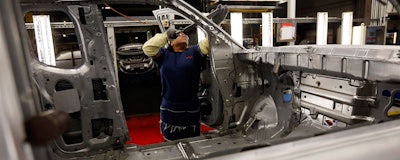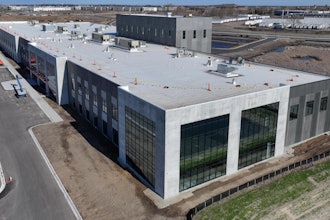
 John Brooks
John Brooks The Just-in-Time (JIT) model has led the field in a more stable business environment, but has proved harder to maintain in a climate of fluctuating currencies, changing labor dynamics and unexpected retail whims.
At the foundation of the JIT model is cooperative collaboration, everyone along the supply chain contributes input into a continuous manufacturing process. Real-time data gives the up to the moment information including: updates on material availability, delivery schedules, manufacturing capacity and staff availability for receiving and loading goods.
Manufacturers can no longer rely on past performance as a guide to next week’s needs, instead there must be real-time data to keep abreast of supplies, price changes, logistics, as well as market fluctuations. The only way to make this possible is by paying attention to the way this mass of data is made accessible.
Too often, data is compiled and shared in a makeshift manner, using whatever resource fits, such as spreadsheets and batch reports. Time, money and energy are wasted on a solution that is clumsy or difficult to use, and management grows reluctant to try anything new.
Data should be made accessible from ERP systems and brought into one powerful view. The more naturally a solution delivers its benefits, the faster it will be adopted and the faster the return on investment.
Each department, and each decision maker, will drive towards a set of Key Performance Indicators (KPIs). While long-range weather forecasts might be KPIs for certain sales teams, and currency fluctuations and changes in minimum wage regulation might sound automated alerts in the finance department, the packaging department is far more concerned about tomorrow’s manufacturing and shipping forecast, the availability of staff and packing materials and transport collection schedules — these will be written large on their chosen dashboards.
Changing External Factors Shape Internal Decisions
In a climate that calls for rapid response to shifting opportunities, sales and finance are not simply looking at internal data. For example, shifts in currency values, trending fashions, new government regulations, economic downturn, unusual weather patterns — these are all external factors that could impact sales and either sound a warning or suggest a new opportunity.
This is the sort of data increasingly available with the right reporting systems, and the sort of opportunity that would convince the sale department that next Christmas presents a golden opportunity to double sales of a particular product. They then pass word onto manufacturing to gear up for the opportunity, without realizing that the product requires components from China that take many weeks to be manufactured and delivered — let alone any limitations of their own manufacturing capacity.
This can be seen as an example of “a little knowledge is a dangerous thing”. A mass of market data stimulates a demand to respond, but they are so busy looking outward for opportunities that they take too little account of inward capabilities. Relying on native reports from traditional ERP (Enterprise Resource Planning) systems is too cumbersome for that sort of dynamic business. Setting up reports requires IT assistance, takes too long and can deliver stale, static data.
Customizing Alerts Gets the Right Information in the Right Hands
Information “noise” is everywhere and can be a distraction. To reduce the interruptions and optimize information delivery, automated alerts can be set on a custom basis. This brings clarity when relying on up to date information from as many sources as possible. In the future this will include data stemming from a growing Internet of Things (IoT), resulting in a torrent of real-time data directly from within the supply, manufacturing and distribution process.
The latest planning tools can automate alerting processes, pushing consistent real-time data into standard company models and sending the results straight back to management, while reducing them to simple, clear alerts for those that only need an initial warning. This way, everyone driving the operation is using their own very clear and simple dashboard, but the underlying data is all the same. If more information should be needed to back up a particular alert, these dashboards can be drilled down into the underlying data and get the full picture.
Plan Ahead and Then Plan Continuously
Agile organizations are learning to manage planning as a continuous process not constrained by the financial year. It may still be appropriate to set regular strategic reviews or to hold a planning meeting in response to some major change, such as what’s shifting in the marketplace, what are the new opportunities that have arisen.
Adjusting on the fly requires real-time data on chosen KPIs, it also means making that data much more widely available across the organization.
A special offer posted on the company website could trigger a surge in orders: so traditionally the website manager should inform the product manager and the product manager should make inquiries to ensure adequate stocks and so on up and down the hierarchy and chains of command.
Unless this is done absolutely consistently according to best practice, there is always a chance that someone along the supply chain gets overlooked — maybe the goods are in stock but a forklift driver is off sick?
Conclusion
Making smarter decisions, and planning strategically in JIT manufacturing environments requires a strategy that synchronizes all the gears of real-time data so that critical data is easily shared among manufacturing teams, from the factory floor to the executive suite.
Real-time data will help mind the KPIs and be accomplished so that information flows seamlessly. Look to invest in the software and reporting systems that pull the right information continuously.
John Brooks is Director of the Hubble team at insightsoftware.com.























